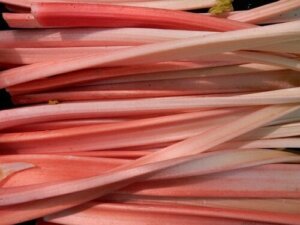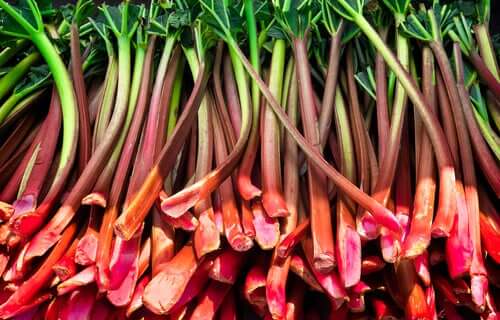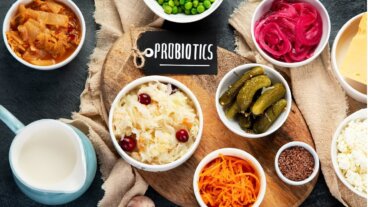Garden Rhubarb: Benefits and Side Effects


Written and verified by the doctor Leonardo Biolatto
The scientific name for garden rhubarb is Rheum rhabarbarum. It belongs to the Polygonaceae family. It’s also edible and you can incorporate its stem into a wide variety of recipes.
Have you ever heard about the many health benefits of this plant?
In ancient times, the plant was mainly used for medicinal purposes, its dry roots in particular. Currently, people use the stems in sweet soups, jams, sauces, cakes, crumbs, and wine. Also, it’s the main ingredient in many traditional cakes and pies in the UK and North America.
The nutritional benefits of garden rhubarb
We must mention that rhubarb doesn’t have too many essential nutrients and its caloric intake is low. Despite this, making it a part of a healthy varied diet can help complement your nutrition needs.
According to information collected in the US Department of Agriculture database, a 3.5 ounce serving of rhubarb contains the following:
- 26 calories
- Less than 0.04 ounces of fat
- 0.07 ounces of fiber
- 0.04 ounces of protein
- 0.2 ounces of carbohydrates
- 0.04 ounces of sugar
- 26% of the recommended daily value of vitamin K1
- 6% of the recommended daily value of vitamin C
- 3% of the recommended daily value of potassium
- 1% of the recommended daily value of folate (vitamin B9)
Rhubarb also contains some calcium. However, it’s usually present in the form of calcium oxalate antinutrients. Despite this, the body cannot efficiently assimilate it.

It may interest you What Are the Evidence-Backed Benefits of Elderberry?
The health benefits of garden rhubarb
You must know scientific studies have still not obtained enough solid evidence on the health benefits of rhubarb. However, anecdotal data and non-official research suggest it may contribute to the prevention of disease.
Let’s see how.
It may help balance cholesterol levels
Rhubarb stalks significantly contribute fiber to a diet, which is well-known for its ability to help regulate cholesterol levels.
In fact, in a controlled study published through the Journal of the American College of Nutrition, the stalk of this plant helped reduce total cholesterol by 8% and bad cholesterol (LDL) by 9%.
Rhubarb contains antioxidants
As per a publication in Research in Pharmaceutical Sciences, antioxidants play an important role in the prevention of chronic diseases. Not only do they lessen the negative effects of free radicals, but they also strengthen the immune system and work as an aid against inflammation.
Rhubarb is a considerable source of antioxidants – even higher than kale, according to a study published by the International Journal of Food, Science & Technology. Specifically, this plant contains anthocyanins, which contribute to your cardiovascular, brain, and skin health.
It supports digestion
The fiber in the rhubarb stalks also has a positive effect on digestive health. Professionals believed its regular consumption can help prevent and treat some gastrointestinal disorders such as constipation.
Also, a study conducted in mice, published in BioMed Research International, mentions that rhubarb tannins help regulate the absorption of water in the digestive tract, which prevents diarrhea.
You might like: What You Need to Know About Hypoparathyroidism
The side effects of garden rhubarb

In the majority of healthy adults, moderate consumption of rhubarb doesn’t have negative consequences. However, we must be clear on the fact that it’s one of the most significant edible sources of calcium oxalate. This mineral is mainly present in the leaves of this plant. Thus, you must avoid eating too much of it.
As detailed in a report published in BMC Nephrology, too much calcium oxalate can lead to hyperoxaluria, a common cause of kidney stones. Furthermore, it can lead to kidney failure if not adequately treated.
Thus, anyone with kidney disorders or a history of stones must avoid eating this vegetable. Also, consult your doctor before consuming it regularly if you’re following a pharmaceutical treatment.
How to take advantage of garden rhubarb
Introducing rhubarb in your diet is relatively easy, despite its sour taste. Some people mix it with strawberries to obtain a sweet and sour flavor. Also, you could also eat it raw, although it won’t be as tasty as when you eat it in a pie! In general, this vegetable is usually mixed with oatmeal, salad dressings, chia seed pudding, and pies, among others.
What do you think? Are you ready to try it?
All cited sources were thoroughly reviewed by our team to ensure their quality, reliability, currency, and validity. The bibliography of this article was considered reliable and of academic or scientific accuracy.
- Rhubarb, raw. (January 4, 2019). United States Department of Agriculture; USDA. Available in https://fdc.nal.usda.gov/fdc-app.html#/food-details/167758/nutrients
-
Heaney RP, Weaver CM. Oxalate: effect on calcium absorbability. Am J Clin Nutr. 1989;50(4):830‐832. doi:10.1093/ajcn/50.4.830
- Goel V, Ooraikul B, Basu TK. Cholesterol lowering effects of rhubarb stalk fiber in hypercholesterolemic men. J Am Coll Nutr. 1997;16(6):600‐604.
- Hajhashemi V, Vaseghi G, Pourfarzam M, Abdollahi A. Are antioxidants helpful for disease prevention?. Res Pharm Sci. 2010;5(1):1‐8.
- Takeoka, G. R., Dao, L., Harden, L., Pantoja, A., & Kuhl, J. C. (2012). Antioxidant activity, phenolic and anthocyanin contents of various rhubarb (Rheumspp.) varieties. International Journal of Food Science & Technology, 48(1), 172–178. https://doi.org/10.1111/j.1365-2621.2012.03174.x
-
Liu C, Zheng Y, Xu W, Wang H, Lin N. Rhubarb tannins extract inhibits the expression of aquaporins 2 and 3 in magnesium sulphate-induced diarrhoea model. Biomed Res Int. 2014;2014:619465. doi:10.1155/2014/619465
-
Albersmeyer M, Hilge R, Schröttle A, Weiss M, Sitter T, Vielhauer V. Acute kidney injury after ingestion of rhubarb: secondary oxalate nephropathy in a patient with type 1 diabetes. BMC Nephrol. 2012;13:141. Published 2012 Oct 30. doi:10.1186/1471-2369-13-141
This text is provided for informational purposes only and does not replace consultation with a professional. If in doubt, consult your specialist.








